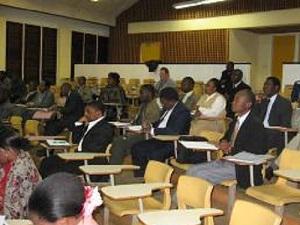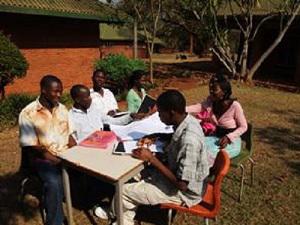Elija Kamundi
Other projects
29 Aug 2008
Sustainable Utilisation and Conservation of Medical Plants that are Used for Treating HIV/AIDS Related Infections in Malawi
The aim of this project is to promote sustainable utilization and management of non-timber forest resources which are used as HIV and AIDs copying strategies in Malawi.

Some of the participants to project sensitization.
The advent of HIV and AIDS found rural Malawians already in precarious state of declining small-scale agriculture and increasing utilization of natural resources particularly forests and woodland resources. The high prevalence of HIV and AIDS is Malawi coupled with the high cost of antiretroviral therapy have forced most people to rely on remedies based on medicinal plants. This has led to overexploitation of most medicinal indigenous plant species. There are more than 15 species of indigenous plants which are used for treating ailments like diarrheal diseases, shingles, fever, rashes, pneumonia, tuberculosis and immune failure.

Part of the group trained in data analysis and interpretation
In Malawi, management of forest resources has focused much on utilization and conservation of trees for fuel wood and timber neglecting the harvest of non-timber products like medicinal plants. Management of medicinal plants is further complicated by the fact that resource users are very secretive due to fear of losing their intellectual property rights. It is against this background that a team of conservationist lead by Elija Kamundi decided to implement a pilot project on management of medicinal plants. The first phase of the project targeted 10 village development committees (VDCs) situated within 5-kilometre belt of the peripheral of Dzalanyama Forest. The shortfall of the first phase was low survival rate of seedling of medicinal plants which were planted due to theft, continuation of open access harvest and bush fires.
These shortfalls will be addressed in the second phase by implementing the following activities:
1) Conducting eight sessions of five-day training workshop on propagation, seed germination techniques, homestead cultivation, management and conservation of medicinal plants.
2) Establishing four permanent demonstration centres on propagation management and conservation of medicinal plants.
3) Conducting eight open day shows to increase awareness on management of medicinal plants.
4) Production of two radio programmes which will enhance dissemination of project results.
Expected results from this project include:
1) increased number of medicinal plant tree seedlings from 20,000 to 400,000 per annum. The targeted species are Anzanza garkiana, Petrocarpus angolensis, Flacourtia indica, Markhamia acuminate, Buurkea Africana, Erythrina abyssinica, Afzelia quanzensis, Cassia abbreviate, Strychnos innocua, Pseudolachnostylis maprouneifolia, antidesma vernosum and Aloe vera.
2) Increased participation of resources users in sustainable utilisation and management of forest resources from 10 VDCs to 20 VDCs.